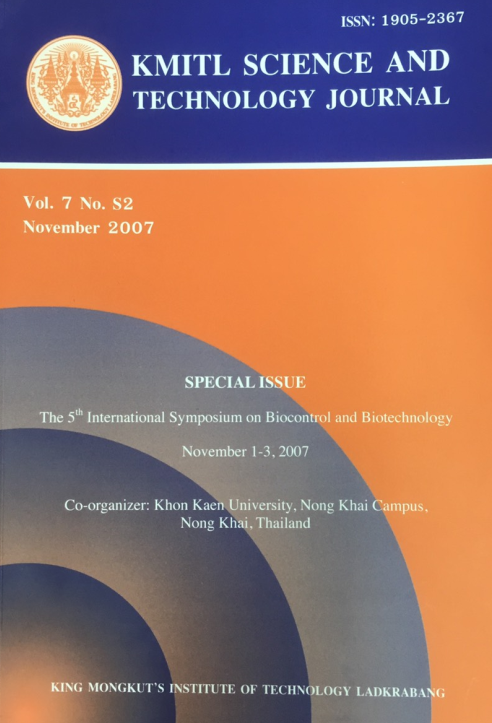FLAVONOID CONTENT AND ANTIOXIDANT ACTIVITY OF KRACHAI-DUM (Kaempferia parviflora) WINE
Main Article Content
Abstract
Wine fermentation was conducted with three different preparations of Krachai-Dum using tamarind juice as a base composition. In the first preparation, pieces of sliced Krachai-Dum were fermented with tamarind juice. For the second preparation, Krachai-Dum extracts were mixed with tamarind juice and used for fermentation process. The third preparation was performed by adding pieces of sliced Krachai-Dum into fermented tamarind wines during aging process. Three types of Krachai-Dum; unpeeled Krachai-Dum slices, peeled Krachai-Dum slices and Krachai-Dum skin were used separately to prepare Krachai-Dum wine. Tamarind juice without Krachai-Dum was used as control. After fermentation, Krachai-Dum wines were kept at 4 ºC for aging process. Total phenolic compounds, flavonoid contents and antioxidant activity were examined in all samples. Total phenolic compounds ranged from 107.00 ± 9.27 to 306.62 ± 6.21 mgGAE/l. Seven flavonoids were detected in all preparations of Krachai-Dum wine except in the control as follows: 5-hydroxy-7-methoxyflavone, 5-hydroxy-3,7,3′,4′-tetramethoxyflavone, 5-hydroxy- 3,7,4′-trimethoxy flavone, 5,7,4′-trimethoxyflavone, 5-hydroxy-3,7-dimethoxyflavone, 3,5,7,3′,4′-penta methoxyflavone and 5,7-dimethoxyflavone. Among these, 3,5,7,3′,4′-pentamethoxyflavone was the major component found in all samples and 5-hydroxy-3,7,3′,4′-tetramethoxyflavone was detected in lowest amount. The total flavonoid contents ranged from 9.59 to 24.41 mg/100ml wine. The wine using Krachai-Dum skin showed higher flavonoid contents than those using peeled or unpeeled pieces. The highest total flavonoid content (24.41 mg/100ml wine) was found in Krachai-Dum wine prepared by adding Krachai-Dum skin to tamarind wine during the aging process of 4 months. In vitro antioxidant activity of wine samples before and after 1, 2, 3, 4 months of aging process was examined by DPPH and FRAP methods. Antioxidant activity of wine samples by both methods showed similar results that the activities are higher in Krachai-Dum wine prepared by fermented peeled or unpeeled Krachai-Dum with tamarind juice than those prepared by Krachai-Dum extracts. Phenolic contents and antioxidant activities in all conditions were in the same direction. The results suggested that the phenolic compounds may play an important role in the antioxidant effect in Krachai-Dum wine. However, the total flavonoid content did not correlate with the antioxidant activity of the sample wines.
Keywords: Kracahi-Dum wine, Kaempferia parviflora, antioxidant, 2,2-diphenyl-1-picrylhydrazyl (DPPH), ferric-reducing antioxidant power (FRAP)
Corresponding author: E-mail: sukanda@kku.ac.th
Article Details
Copyright Transfer Statement
The copyright of this article is transferred to Current Applied Science and Technology journal with effect if and when the article is accepted for publication. The copyright transfer covers the exclusive right to reproduce and distribute the article, including reprints, translations, photographic reproductions, electronic form (offline, online) or any other reproductions of similar nature.
The author warrants that this contribution is original and that he/she has full power to make this grant. The author signs for and accepts responsibility for releasing this material on behalf of any and all co-authors.
Here is the link for download: Copyright transfer form.pdf
References
[2] Sennil, J., and Trichalee, M. 2003 Krachai-Dum: Amazing Herb Book 2. KMP. Siam Media, Bangkok: 42-50. (In Thai)
[3] Tewtrakul, S. and Subhadhirasakul, S. 2007 Anti-allergic Activity of Some Selected Plants in the Zingiberaceae Family, Journal of Ethnopharmacology, 109, 535-538.
[4] Rujjanawate, C., Kanjanapothi, D., Amornlerdpison, D. and Pojanagaroon, S. 2005 Anti gastric Ulcer Effect of Kaempferia parviflora, Journal of Ethnopharmacology, 102, 120-122.
[5] Patanasethanont, D., Nagai, J., Matsuura, C., Fukui, K., Suutthanut, K., Sripanidkulchai, B-O., Yumoto, R. and Takano, M. 2007 Modulation of Function of Multidrug Resistance Assocaited-proteins by Kaempferia parviflora Extracts and Their Components, European Journal of Pharmacology, 566, 67-74.
[6] Pojanagaroon, S., and Rujjanawate, C. 2005 Effect of Internal Color of Kaempferia parviflora (Krachai-Dam) Rhizomes as Raw Materials for Wine Processing on Antioxidative Activity. Proceedings of 43rd Kasetsart University Annual Conference, Thailand, 1-4 February.
[7] Que, F., Mao, L., Zhu, C. and Xie, G. 2006 Antioxidant Properties of Chinese Yellow Wine, Its Concentrate and Volatiles, Lebensmittel- Wissenschaft und Technologie (LWT), 39, 111-117.
[8] Villaño, D., Fernández-Pachón, M.S., Troncoso, A.M. and García-Parrilla, M.C. 2006 Influence of Enological Practices on the Antioxidant Activity of Wines, Food Chemistry, 95, 394-404.
[9] Katalinic´, V., Milos, M., Modun, D., Music´, I. and Boban, M. 2004 Antioxidant Effectiveness of Selected Wines in Comparison with (+)-Catechin, Food Chemistry, 86, 593-600.
[10] Katalinic´, V., Modum, D., Music´, I. and Boban, M. 2005 Gender Differences in Antioxidant Capacity of Rat Tissues Determined by 2,2´-azinobis (3-ethylbenzothiazoline 6-sulfonate; ABTS) and Ferric Reducing Antioxidant Power (FRAP) Assays. Comparative Biochemistry and Physiology, 140, (Part C), 47-52.
[11] Milardovic, S., Ivekovic, D. and Grabaric´, B.S. 2005 A Novel Amperometric Method for Antioxidant Activity Determination Using DPPH Free Radical, Bioelectrochemistry, 68, 180-185.
[12] Minussi, R.C., Rossi, M., Bologna, L., Cordi, L., Rotilio, D., Pastore, G.M., and Duran, N. 2003 Pheolic Compounds and Total Antioxidant Potential of Commercial Wines, Food Chemistry, 82, 409-416.
[13] Fernandez-Pachon, M. S., Villaono, D., Garacia-Parrilla, M.C., and Troncoso, A.M. 2004 Antioxidant Activity of Wines and Relation with Their Polyphenolic Composition, Analytica Chimica Acta, 513, 113-118.


